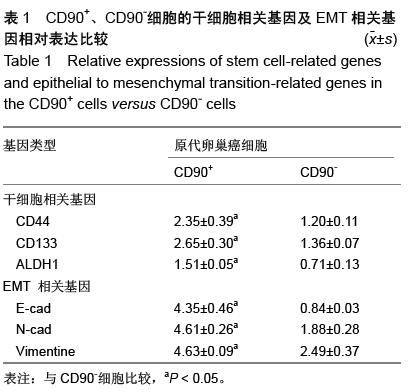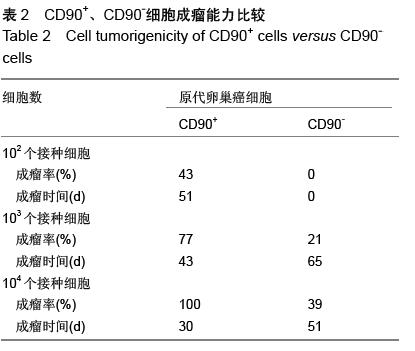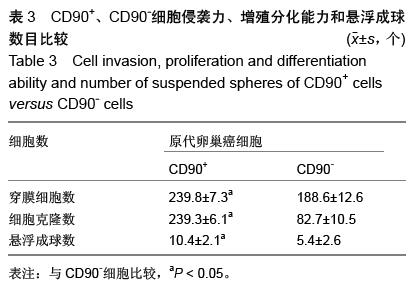| [1] 朱正,戴景蕊,赵燕风,等.卵巢颗粒细胞瘤的CT表现[J].临床放射学杂志,2010,29(4):478-481.[2] 陈本宝,王泽,张善华,等.卵巢颗粒细胞瘤的CT表现与病理对照分析[J].实用放射学杂志,2008,24(7):931-933.[3] 赵文华. 卵巢癌危险因素研究进展[J].国际妇产科学杂志,2013,40(1):50-53.[4] 黄冬梅,张新玲,郑荣琴,等.声学造影在子宫肿瘤诊断中的应用[J].中国医学影像技术,2006,22(2):199-201.[5] 邓凤莲,邹建中,李锐,等.高强度聚焦超声治疗子宫肌瘤对骶骨影响因素探讨[J].中国介入影像与治疗学,2009,6(5): 457-460.[6] 卢金镶,申培红,张全武,等.卵巢无性细胞瘤PLAP、NSE和PRL检测的临床意义.医学论坛杂志,2007,28(8):48-49.[7] Phillips TM, McBride WH, Pajonk F. The response of CD24(-/low)/CD44+ breast cancer-initiating cells to radiation. J Natl Cancer Inst. 2006;98(24):1777- 1785.[8] Akhtar K, Bussen W, Scott SP. Cancer stem cells - from initiation to elimination, how far have we reached? (Review). Int J Oncol. 2009;34(6):1491-1503.[9] Baumann U, Crosby HA, Ramani P, et al. Expression of the stem cell factor receptor c-kit in normal and diseased pediatric liver: identification of a human hepatic progenitor cell. Hepatology. 1999;30(1): 112-117.[10] True LD, Zhang H, Ye M, et al. CD90/THY1 is overexpressed in prostate cancer-associated fibroblasts and could serve as a cancer biomarker. Mod Pathol. 2010;23(10):1346-1356.[11] 张毅,窦科峰,宋文杰,等. MHCC97中边缘群细胞的成瘤性及其侵袭性观察[J].第四军医大学学报,2008,29(3): 252-254.[12] 陈瑞雪,李艳红,马晓晶,等.电针治疗卵巢早衰的疗效观察[J].中国中医基础医学杂志,2009,15(3):208.[13] 苗小芬,许小凤,陈宣伊,等.补肾活血组方对大鼠卵巢颗粒细胞的作用[J].苏州大学学报:医学版,2010,30(4): 741-743.[14] 王红梅,李莲,米慧茹,等.针刺对卵巢早衰患者性腺激素及体重的影响[J].中国中医基础医学杂志,2011,17(2): 204-205.[15] Mukherjee T, Copperman AB, Lapinski R, et al.An elevated day three follicle-stimulating hormone: luteinizing hormone ratio (FSH:LH) in the presence of a normal day 3 FSH predicts a poor response to controlled ovarian hyperstimulation.Fertil Steril. 1996; 65(3):588-593.[16] Moher D, Pham B, Jones A, et al. Does quality of reports of randomised trials affect estimates of intervention efficacy reported in meta-analyses. Lancet. 1998;352(9128):609-613.[17] Yong PY, Baird DT, Thong KJ, et al. Prospective analysis of the relationships between the ovarian follicle cohort and basal FSH concentration, the inhibin response to exogenous FSH and ovarian follicle number at different stages of the normal menstrual cycle and after pituitary down-regulation. Hum Reprod. 2003;18(1):35-44.[18] 李逸仙,孙保存,刘志勇,等.血管内皮诱导培养基促进结肠癌细胞向血管内皮细胞方向分化的研究[J].中国肿瘤临床,2014,41(10):996-999.[19] 张世杰,王蕾,王月颖,等.人VSIG4基因转染细胞的构建及其对T细胞的共刺激效应的初步研究[J].中国免疫学杂志, 2009,25(5):397-401.[20] 邓展生,张璇,邹冬青,等.骨碎补各种提取成分对人骨髓间充质干细胞的影响[J].中国现代医学杂志,2005,15(16): 2426-2429.[21] 黄万钟,姚月华,钟瑜,等.吉西他滨联合卡培他滨治疗耐药性乳腺癌近期疗效观察[J].现代肿瘤医学,2010,18(6): 1143-1145.[22] 夏俊贤,陈敬华,田忠凯,等.3种不同化疗方案二线治疗复发性卵巢癌的对比研究[J].肿瘤基础与临床,2013,26(3): 210-212.[23] 李小平,董丽,魏丽惠,等. 卵巢上皮性癌序贯化疗41例临床分析[J].中国妇产科临床杂志,2009,10(1):37-40.[24] 张华,李苏宜.CD133与肿瘤干细胞研究进展[J].癌症, 2010,29(3):259-264.[25] 张弦,蒋翠莲,王宝偲, 等. 基于SP细胞分选法初步鉴定卵巢癌干细胞表面标志[J].东南大学学报:医学版,2009, 28(6):491-496.[26] 施敏凤.人卵巢癌肿瘤干细胞样细胞的分离、鉴定及对化疗药物敏感性的研究[D].杭州:浙江大学医学院,2010.[27] 宣自学,袁守军,李晓雯.靶向肿瘤血管形成的抗肿瘤作用及药物研究进展[J].中国新药杂志,2014,23(3): 282-288.[28] 贺路航,向橦,张艳玲,等.CD133+卵巢癌干细胞样细胞向血管内皮细胞分化的实验研究[J]. 第三军医大学学报, 2014,36(5): 413-416.[29] 张诗武,郭华,张丹芳,等.黑色素瘤组织内三种血液供应模式时间关系的初步探讨[J].中国肿瘤临床,2007,34(2): 96-99.[30] 罗晓琴,杨国旺,徐咏梅,等.非小细胞肺癌气虚血瘀证患者血清血管内皮生长因子及内皮抑素的表达及意义[J].首都医科大学学报,2009,30(4):445-448.[31] Virant-Klun I, Kenda-Suster N, Smrkolj S. Small putative NANOG, SOX2, and SSEA-4-positive stem cells resembling very small embryonic-like stem cells in sections of ovarian tissue in patients with ovarian cancer. J Ovarian Res. 2016;9(1):12. [32] Chen Q, Liu X, Xu L, et al. Long non-coding RNA BACE1-AS is a novel target for anisomycin-mediated suppression of ovarian cancer stem cell proliferation and invasion. Oncol Rep. 2016 Jan 18. [Epub ahead of print][33] Zhang R, Zhang P, Wang H, et al. Inhibitory effects of metformin at low concentration on epithelial-mesenchymal transition of CD44(+)CD117(+) ovarian cancer stem cells. Stem Cell Res Ther. 2015; 6(1):262.[34] Yao X, Dong Z, Zhang Q, et al. Epithelial ovarian cancer stem-like cells expressing α-gal epitopes increase the immunogenicity of tumor associated antigens. BMC Cancer. 2015;15:956. [35] Ishiguro T, Sato A, Ohata H, et al. Establishment and Characterization of an In Vitro Model of Ovarian Cancer Stem-like Cells with an Enhanced Proliferative Capacity. Cancer Res. 2016;76(1):150-160. [36] Bar JK, Grelewski P, Lis-Nawara A, et al. The role of cancer stem cells in progressive growth and resistance of ovarian cancer: true or fiction. Postepy Hig Med Dosw (Online). 2015;69:1077-1086.[37] Burgos-Ojeda D, Wu R, McLean K, et al. CD24+ Ovarian Cancer Cells Are Enriched for Cancer-Initiating Cells and Dependent on JAK2 Signaling for Growth and Metastasis. Mol Cancer Ther. 2015;14(7):1717-1727. [38] Kitayama J, Emoto S, Yamaguchi H, et al. CD90+ mesothelial-like cells in peritoneal fluid promote peritoneal metastasis by forming a tumor permissive microenvironment. PLoS One. 2014;9(1):e86516.[39] Wei Z, Wang Y, Yu X, et al. Identification and characterization of stem cells in an ovarian cancer cell line and examination their drug resistance. Zhonghua Fu Chan Ke Za Zhi. 2015;50(6):452-457.[40] Zhou Q, Chen A, Song H, et al. Prognostic value of cancer stem cell marker CD133 in ovarian cancer: a meta-analysis. Int J Clin Exp Med. 2015;8(3): 3080-3088.[41] 廖世平,高青.胃癌组织中血管生成拟态的临床意义[J].胃肠病学和肝病学杂志,2012,21(11):997-999.[42] 李燕妮,王爱丽,黄守国.腹腔镜与剖腹手术治疗卵巢良性囊肿疗效比较[J].中国现代手术学杂志,2008,12(5): 392-394.[43] 李青.两种手术方法治疗卵巢囊肿对比分析[J].中国误诊学杂志,2010,10(13):3056-3057.[44] 张瑞作,刘继秀.腹腔镜手术与开腹手术治疗良性卵巢囊肿的临床观察[J].微创医学,2011,6(5):467-468.[45] 王世凤.腹腔镜与开腹手术治疗卵巢囊肿与输卵管妊娠疗效比较[J].现代中西医结合杂志,2009,18(7):757-758.[46] 王静,王佩珍.腹腔镜与开腹手术治疗良性卵巢囊肿的疗效分析[J].河北医学,2008,14(4):450-443.[47] 李燕妮,王爱丽,黄守国.腹腔镜与剖腹手术治疗卵巢良性囊肿疗效比较[J].中国现代手术学杂志,2008,12(5): 392-394.[48] 谢伟,龙海霞,张恒,等.人卵巢癌细胞系 A2780 中肿瘤干细胞的分离及鉴定[J].第三军医大学学报,2011,33(4): 356-359.[49] 郭汉青,严惠,李铤,等.胃癌干样细胞向内皮细胞分化的研究[J].现代肿瘤医学,2013,21(5):922-926.[50] 潘鹏,田福起,郭涛,等.无血清悬浮培养肾癌干细胞表面标志CD133及端粒酶活性的表达[J].中国组织工程研究与临床康复,2009,13(27): 5286-5290. |
.jpg)



.jpg)